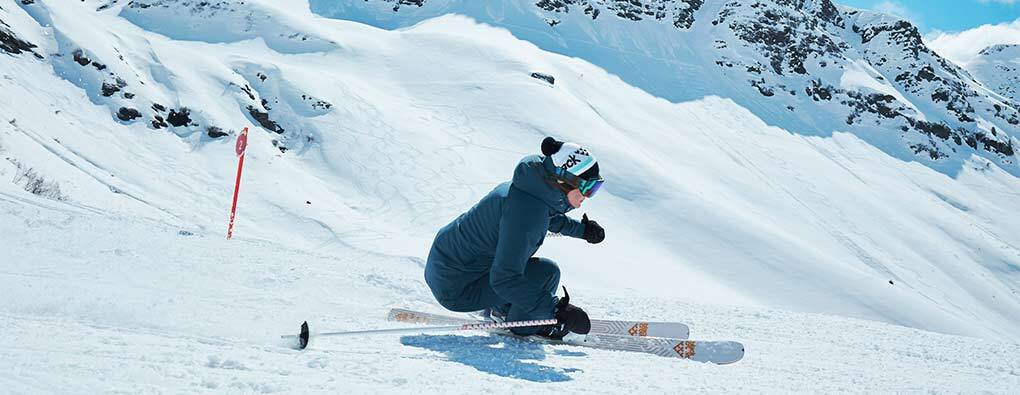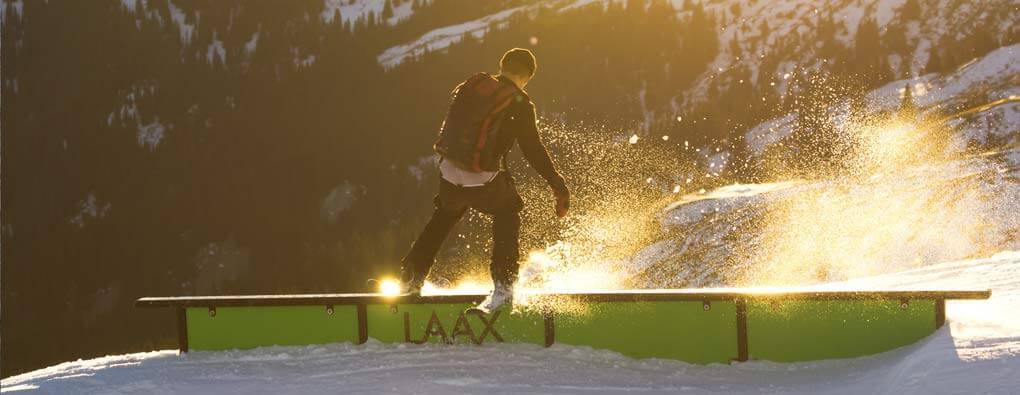Choosing Skis for Intermediate Skiers
This guide is ideal for those who have been skiing for a while and are looking for skis suitable for their proficiency. As your skiing skill progresses beyond the beginner stage, you'll require skis that offer better responsiveness to further boost your confidence.
There is a vast selection of advanced skis available, so prioritising the type of terrain or style you frequently ski will help in selecting the perfect skis. Considering aspects like width, turn radius, and ski profiles will aid in tailoring your preferences. We aim to help you find the ideal skis suited to your skiing habits so that you can fully enjoy your skiing holiday.
If you are new to skiing or still honing your skills as a beginner, we've put together a guide specifically for you. For more details, check out our Guide to Buying Skis for New Skiers.
ALL MOUNTAIN SKIS - Your Go-To Skis for Versatile Terrain

All Mountain skis are great for those who love mixing on-piste with off-piste skiing. While primarily functioning well on groomed pistes, they can also manage softer snow found off-piste. These skis allow you to enjoy a full day without fretting over varying snow quality. Although versatile across different snow conditions, they aren't specifically designed for one type of terrain. Another feature is the rocker tip, enabling easy turns and better handling in challenging conditions. If you plan on owning just one set of skis for everything, look no further.
Selecting All Mountain Skis:There are plenty of All Mountain skis, each excelling in different snow conditions. Focusing on waist width can refine your choices. Typically, All Mountain skis have a waist width ranging from 80-100 mm. Narrower skis cater more towards piste, while wider ones perform better off-piste. If you primarily stick to the piste and occasionally venture off, opt for skis closer to 80 mm. Conversely, if exploring softer snow alongside pistes attracts you, consider wide skis nearing 100 mm. Buy Your All Mountain Skis
PISTE SKIS - Superior Carving on Prepared Slopes

For individuals spending the majority of their skiing time on groomed slopes and concentrating on perfecting their technique, Piste skis are a fitting choice. These skis are constructed with a narrow waist of 68 - 80 mm and feature a camber profile, providing excellent grip and control on firm snow surfaces.
Opting for Piste Skis:
Skiers who predominantly ski on-piste tend to develop a style that prefers certain turn sizes. Selecting skis with a matching turn radius will maximize their potential. Piste skis usually feature a turning radius between 13-17 m, with smaller figures for tighter turns and larger ones for wider turns. Be aware of the wide selection of Piste Skis available and ensure to pick ones suitable for your ability. Beginner skis offer more flexibility, while expert skis are sturdier and heavier.
Within Piste skis, one can also find high-performance Race skis which are typically rigid and designed for speed. Slalom Race Skis (SL) have a compact turning radius of around 10-13 m, whereas Giant Slalom Race Skis (GS) feature a substantial turning radius of 22 m and beyond, offering enhanced stability.
Buy Your Piste SkisPARK SKIS/TWIN TIP SKIS - Ideal for Stunts and Tricks

Park skis are especially made for enthusiasts aiming to engage in snowpark activities, such as jumps, boxes, and half-pipes. A defining trait is the twin tip, which means both ends of the ski are slightly elevated, allowing skiers to land backwards without catching the tails in the snow. Bindings are typically centrally mounted to aid balance during spins and jumps.
Picking Park Skis:To choose the right Park skis, consider the tricks you aim to execute. If you want to enjoy yourself with tricks mainly on boxes and rails, opt for Park skis with a broader waist, approximately 85mm to 105mm, for added stability. These tend to be softer and more flexible. For those wanting higher speed and larger jumps, opt for narrower skis between 80-95 mm, which are more rigid to provide stability in quicker movements or upon landing. Buy Your Park Skis
FREERIDE SKIS / Powder SKIS - The Ultimate for Snowy Explorations

Freeride skis are perfect for those who spend most of their skiing in off-piste or powdery locations. With wide waists of 90-120 mm and a tip rocker, these skis allow you to glide effortlessly over snowy surfaces, making turning much easier. Mastering skiing on groomed pistes is beneficial before embarking on freeride skiing, as navigating the deep snow requires a different technique. To fully enjoy such adventures safely, avalanche safety equipment is highly recommended.
Choosing Freeride Skis:Deciding on the right waist width for your freeride style will help you make an informed decision. Wide skis (100 mm and above) are ideal for deep snow, providing flotation and conserving energy. However, they're unsuitable for piste skiing due to limited grip on firm snow. If you seek versatility, wide skis from 90-100 mm are a better choice, especially for navigating soft snow adjacent to treelines.
In essence, wider skis float better in powder but aren't as agile on compact snow. Buy Your Freeride Skis
TOURING SKIS / Backcountry SKIS - Excelling Beyond the Ski Resort

Touring skis cater to thrill-seekers eager to travel beyond marked trails. They entail gear like touring bindings and skins, which ease climbing before descending. Ski widths range from medium to wide (80 - 120 mm), and they're lighter to facilitate easier ascents. This ski type is specialised and requires substantial experience, thereby more suited to seasoned skiers. Essential safety gear includes avalanche equipment.
Touring Skis Selection:When selecting touring or backcountry skis, note your preference for uphill or downhill focus.
Touring skis leaning towards downhill and often in powder conditions will generally be longer (up to 10 cm less than body length) and might have a wider width (95 mm and upwards). Conversely, for uphill preference, shorter skis around chin height and narrower widths (95 mm and under) are optimal to reduce weight. Buy Your Touring Skis
Determine the Correct Ski Length
Your chosen ski length should primarily correspond with your height, ability level, and the style of skiing you intend to pursue.
Most skis feature four or five sizing options, allowing you to align closely to your ideal length as per the size chart (a difference of 3cm longer or shorter is acceptable).
Body weight and skiing style are secondary considerations for ski length. If your weight deviates significantly from average, opt for longer or shorter skis accordingly. Heavier individuals might choose longer skis, while lighter individuals might benefit from shorter options. Furthermore, a more aggressive or faster skier can gain stability with longer skis, whereas a cautious skier might prefer shorter skis for enhanced agility.
The image demonstrates the ski length suitable for an intermediate skier
| All Mountain/ Piste skis |
Twintip/ Park skis |
Freeride/ Backcountry |
|
| First-timer | your height -20 cm | -10 cm | -5 cm |
| Beginner | your height -15 cm | -10 cm | -5 cm |
| Intermediate | your height -10 cm | -5 cm | your height |
| Advanced | your height -5 cm | your height | your height |
| Expert | your height | your height | +5 cm |
Skis: With or Without Bindings
Bindings are crucial for safety and attachment to your skis. Most All Mountain and all Piste skis are equipped with bindings, making it hassle-free as they suit the skill level of the selected skis. These skis offer easy size adjustments, suitable for those renting ski boots or sharing skis within a family.
Skis purchased without bindings necessitate buying bindings separately, allowing for customised options and placement on the skis. This is particularly advantageous for seasoned Freeride or Park skiers. While mounting services may be quite costly, if you purchase skis with bindings from SkatePro, we mount and adjust them for a competitive fee. Further details on bindings are available in the Buying alpine ski bindings guide.
Waist Measurement
In addition to length, ski width significantly impacts performance, with waist width being the most crucial measurement. The waist is the narrowest section of the ski, measured edge to edge in millimetres.
The waist width is always indicated in the ski specifications, alongside the tip and tail measurements: Tip - Waist - Tail. Thus, the waist width is situated in the middle. For example: (i.e. 141/108/124mm)
Skis with narrow waists are generally easier to turn as they require minimal time to shift from one edge to another. The skier's pressure and weight are more concentrated over a smaller area, enhancing the snow grip. Skis with wider waists have larger surfaces, which boosts their capability to float on powder snow and provides stability over uneven terrains.
Turning Radius Explanation
Simply put, the ski radius influences how smoothly the skis can turn. This detail is typically included in the ski model's specifications.
The ideal turning radius varies according to skiing style and ski type. Turning radii are categorised as small, medium, and large.
Skis with a small turning radius, having a radius of 14 meters or less, excel on groomed snow and are ideal for skiers who enjoy making quick, short turns.A medium turning radius is common in All Mountain skis with radii ranging from 15 to 18 meters, perfect for skiers who enjoy both on and off-piste skiing.
Skis with a large turning radius, which exceed 19 meters, are typically found in Freeride skis. They offer remarkable stability in deep snow or at high speeds, tailored for fast, aggressive skiing.
Ski Profiles: Rocker and Camber
CAMBER
Camber skis have an arched curve that spans much of the ski, causing the central part to lift off the snow. This design increases pressure at the tip and tail, thereby enhancing edge control. Camber is prevalent in almost all Piste skis, as well as many All Mountain and Freeride models.
ROCKER/REVERSE CAMBER
Skis featuring a rocker profile possess an upward curve at the tip, and sometimes at both the tip and tail. Rocker design enhances buoyancy on deep snow and facilitates easy initiation and completion of turns. It is common across most ski types, although some exceptions exist within Piste skis.
FULL ROCKER
This profile is designed to perform excellently in powder snow, simplifying turning. Due to both the tip and tail being off the snow, it is forgiving and generally feels shorter than its actual length.
TIP ROCKER
Offers a balanced combination of manoeuvrability and effective edge control. The camber runs along much of the ski's length to ensure excellent grip and control, while the tip rocker adds playfulness and improves performance in powder snow.
TIP AND TAIL ROCKER
This combination of rocker and camber results in a versatile ski profile. The tip and tail rocker ensure performance on powder snow, and the camber component enhances All Mountain capabilities. On-piste, the skis feel slightly shorter due to the rockered tips and tails.
TWINTIP
The raised tip and tail facilitate skiing backwards, along with landing or taking off from jumps inversely, offering a playful experience. Bindings are usually centred for better balance while performing tricks.









